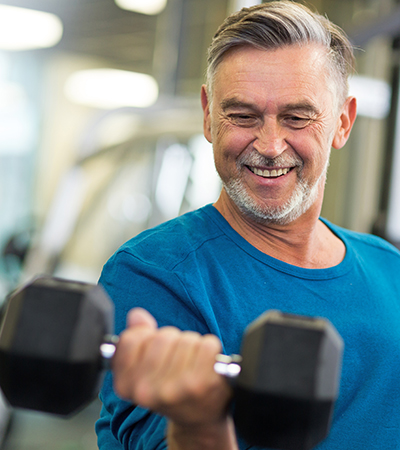
Get Moving
Your body was meant to move. Whether you like to dance, hike, walk in the park or ride bikes, let it do its thing! Daily physical activity does more than help manage your weight. It builds strong bones, maintains muscle mass, helps burn off stress, keeps your core muscles in check (important for balance), makes you feel good about yourself and maintains a strong heart.
What type and how often?
If you do not participate in any form of physical activity, but would like to begin, it's essential to start off small and slow. First and foremost, consult a physician before you start working on the three components of physical fitness: cardiovascular endurance, muscular strengthening and flexibility.

Cardio
Cardiovascular endurance is simply participating in activities that increase your heart rate to improve the strength of your heart.
Cardio activities can vary depend on your current level of fitness and mobility: anything from walking to playing pick up basketball. If you are looking for ways to increase your cardio fitness, think of activities you enjoy rather than what you think you should do. This will help to maintain being active versus ending within a week!
- Start off small- 5-10 minutes for the first few days or week.
- Start off slow- at an intensity where you are just breaking a sweat. If you can hold a conversation without losing breath when you are active, you are at the appropriate level of intensity.
- Once you can handle this duration and intensity, slowly increase one or both (maybe to 15 minutes where the last 5 minutes you are sweating, though not profusely).
Strengthening
Muscular strengthening is what we think of when we lift weights or do push ups, pull ups and crunches. If done properly, increasing your muscular strength will not only help improve your metabolism, make your body feel tighter and slimmer, it will also help protect your joints such as your knees. The U.S. Department of Health and Human Services 2nd Physical Activity Guidelines for Americans state adults should do muscle-strengthening activities of moderate or greater intensity that involve all major muscle groups 2 or more days each week.
The best way to begin a weight lifting regimen is to meet with a certified personal trainer for a personalized routine and to learn proper technique.
If you cannot afford to join a gym or meet with a trainer, using your body's weight, such as doing push ups or squats at home, and common household items like cans of soup is sufficient to get started.
- Start off small- don't lift weights that you cannot do comfortably while maintaining your form for 10-15 repetitions.
- Start off slow- the slower you go, the more you work your muscles. Also, begin with only one set of 10-15.
- Once you get to a point where one set is a breeze, either increase the weight or number of sets but not both at the same time!
Flexibility
Flexibility is the most common overlooked key to fitness. Being flexible helps protect joints, lengthen muscles and the process helps relax your entire body. To increase flexibility, incorporate stretching into your daily routine. It is best to stretch warm muscles (i.e.: after you work out or do a warm up) rather than trying to stretch them cold. The more often you stretch, the greater your range of motion will be.
- Start off small- stretch only to the point of slight tension, never to pain!
- Start off slow and remain slow- hold your stretches for at least 30 seconds to allow your muscles to relax entirely before moving on to the next stretch.
For more information on becoming active, speak to a certified personal trainer and visit reputable websites like the American College of Sports Medicine, American Council on Exercise and President's Council on Sports, Fitness & Nutrition.
How often?
According to the U.S. Department of Health and Human Services 2nd Physical Activity Guidelines for Americans, adults should spread aerobic activity [e.g.: cardio] throughout the week and aim for:
- At least 150 to 300 minutes of moderate-intensity aerobic activity OR
- 75 minutes to 150 minutes of vigorous-intensity aerobic activity OR
- An equivalent combination of moderate- and vigorous-intensity aerobic activity
Reviewed 5/25/2023

